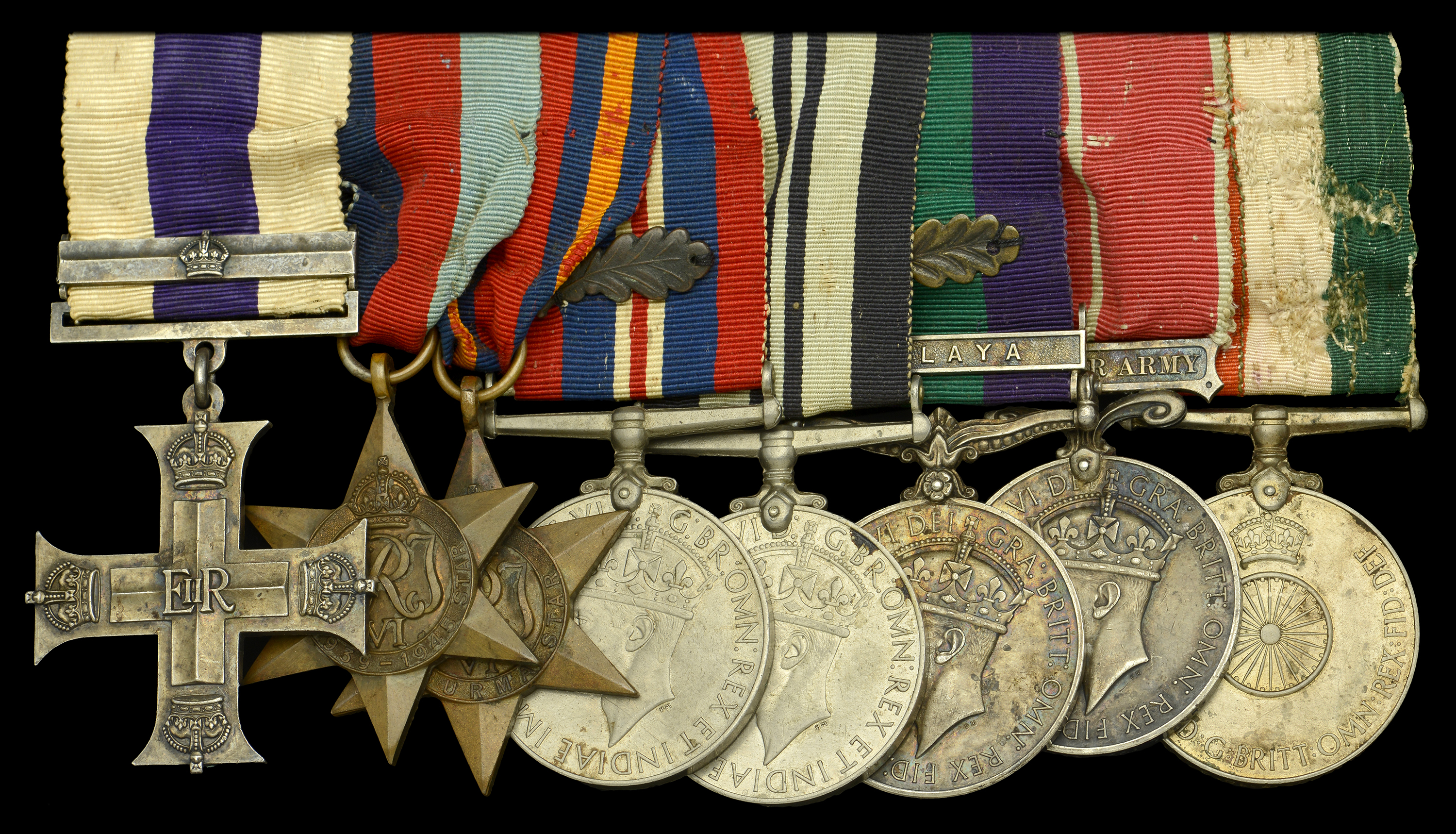An extremely rare post-War ‘Malayan Emergency’ M.C. and Second Award Bar group of eight awarded to Lieutenant Sudhaman Rai, 7th Duke of Edinburgh’s Own Gurkha Rifles, who was decorated for ‘cunning and tactical skill’ against Communist Terrorists and was thrice Mentioned in Despatches; ‘when a determined enemy rolled hand grenades down a hill towards him, he personally retaliated using well-aimed rifle grenades’ - evidence of his work clearly displayed by the pools of blood left behind on the summit Military Cross, E.II.R., reverse officially dated 1954, with Second Award Bar, reverse officially dated 1955; 1939-45 Star; Burma Star; War Medal 1939-45, with M.I.D. oak leaf; India Service Medal; General Service 1918-62, 1 clasp, Malaya, G.VI.R., with M.I.D. oak leaf (Lt. Sudhaman Rai. 7.G.R.); Army L.S. & G.C., G.VI.R., 2nd issue, Regular Army (408509 Lt. (KGO). Sudhaman Rai 7 G.R.); Indian Independence Medal 1947 (21145556 W.O. Cl.2. Sudhaman Rai. G.R.) mounted as worn, the L.S. & G.C. medal on incorrect riband, wear to high relief of GSM, generally very fine and better (8) £5,000-£7,000 --- M.C. London Gazette 29 June 1954. The original recommendation states: ‘Lieutenant Sudhaman Rai Commands a platoon of “D” Company 1/7 Gurkha Rifles and has been actively and continuously engaged in operations since the start of the Emergency. Due to his courage, leadership and initiative his platoon has killed a large number of bandits. The majority of these kills have not been on information, but have resulted from persistent and unceasing patrolling, and ambushes carried out by Lieutenant Sudhaman with an outstanding degree of cunning and tactical skill. This officer has himself killed at least seven of his platoon’s total, two of these he accounted for when on a two man patrol in August of this year. The skill, initiative and personal bravery of Lieutenant Sudhaman Rai have provided an outstanding example not only to the men of his platoon but also to the whole battalion.’ M.C. Second Award Bar London Gazette 31 May 1955. The original recommendation states: ‘On 21st October, 1954, Lieutenant Rai was in command of Number 12 Platoon of 1/7th Gurkha Rifles, a total strength of 16 men all told. Since the morning of 20th October, 1954, he has been following tracks made by a number of Communist Terrorists, and had orders to find out where they were going and on no account to come to action, unless his presence became known. While climbing an extremely steep hill accompanied by only 2 other men, he suddenly came upon a large occupied Communist Terrorists Camp. The Communist Terrorists saw him at the same time and instantly opened fire. This officer immediately ordered his men to take cover and himself placed his platoon in position where they came up, to form as near an encirclement as he could. One rifleman was wounded in the first burst, and had to go to the rear with another soldier to dress his wounds. A second soldier was sent to act as escort to the platoon signaller who was trying to get wireless contact with higher formation. This left the Officer with 11 Riflemen and Non-Commissioned officers, besides himself. For 3 hours this officer by his personal example and bravery kept his platoon in their exposed positions, with the full weight of the enemy fire coming down on them from a prepared and overlooked position. It is known that the enemy possessed 2 Light Machine Guns and other light automatics. Nevertheless, by his superb fire control and leadership, this officer enabled his platoon to beat back 2 or 3 determined attempts by the enemy to dislodge him. Not content with this, he personally took the platoon EY Rifle to an advantageous position and himself fired 6 grenades from it at the enemy. The effects of these grenades undoubtedly demoralised the enemy to a great extent, and it is suspected that several were wounded by them. Throughout this action, the enemy were rolling hand grenades down the hillside on to 12 platoon positions, and were using sustained automatic fire. Despite these adverse conditions, the skilful and brave way in which this small party of men fought back, eventually forced the enemy to withdraw, leaving one of their own dead, and pools of blood to lead to the supposition that at least 3 or 4 were wounded. Throughout this action Lieutenant (QGO) Sudhaman Rai displayed the greatest bravery, leadership and military skill.’ M.I.D. London Gazette 9 May 1946; 19 September 1946; and 1 May 1953. Sudhaman Rai initially served in the ranks with the Gurkha Regiment during the Second World War and was twice Mentioned in Despatches for service in Burma against the Japanese Imperial Army. Appointed to a Commission in the 7th Gurkha Rifles on 4 July 1949, Sudhaman Rai joined an extensive deployment of British and Gurkha troops in Malaya detailed to combat the insurgent threat. They typically drew upon the skills learned during the jungle campaign in Burma, with the 48th Gurkha Brigade and 17th Gurkha Division forming the backbone of the British deployment during the Emergency. One of just 20 officers awarded a post-Second War M.C. and Bar, Sudhaman Rai was further ‘mentioned’ for service in Malaya in 1953, before taking retirement on account of disability on 31 May 1959. Sold with copied research.





